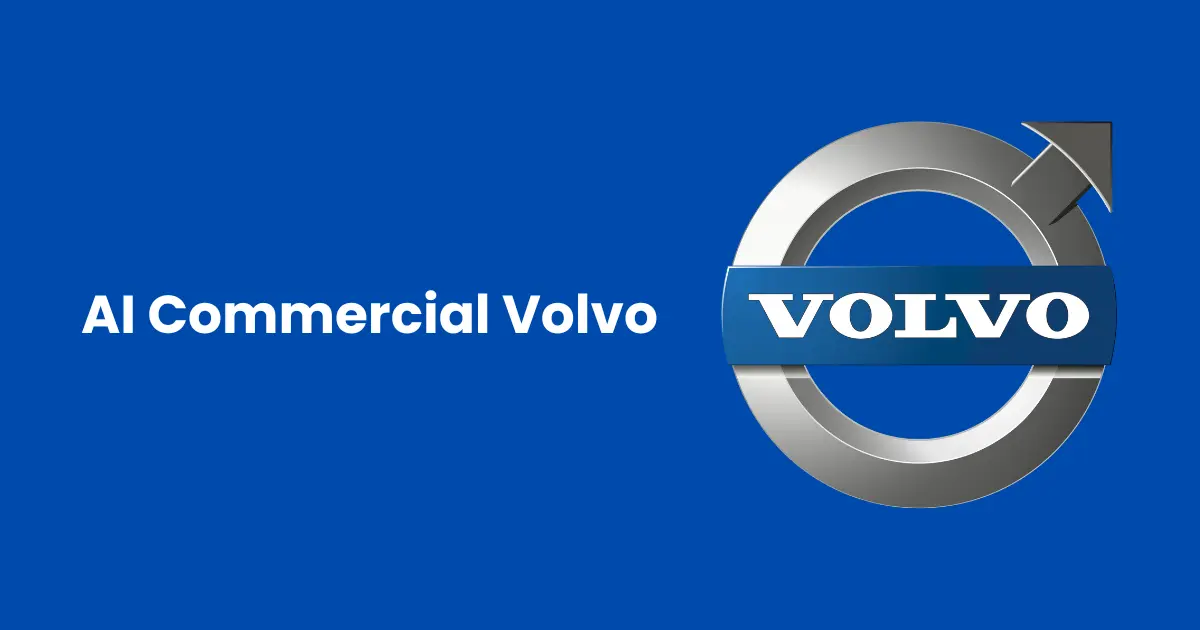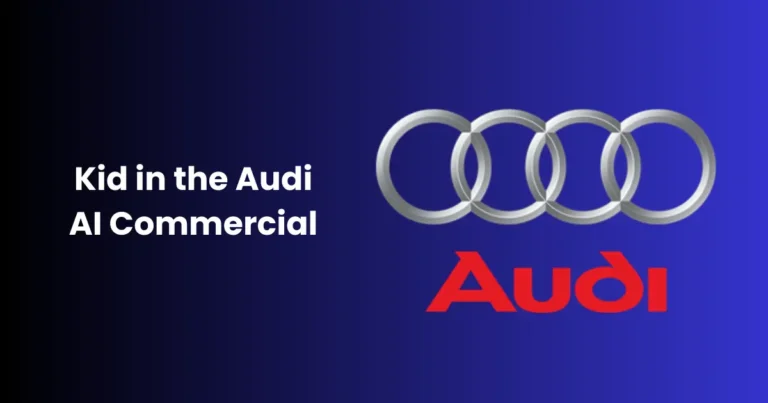AI Commercial Volvo | The Role of AI in Volvo’s Commercial Sector

Contents
- 1 What Makes AI Commercial Volvo Unique?
- 2 The Role of Artificial Intelligence in Volvo’s Commercial Sector
- 3 Benefits of AI Integration in Volvo Commercial Vehicles
- 4 Real-Life Applications of AI in Volvo’s Commercial Vehicles
- 4.1 1. Autonomous Driving Technology
- 4.2 2. Predictive Maintenance
- 4.3 3. Fleet Management and Route Optimization
- 4.4 4. Advanced Driver Assistance Systems (ADAS)
- 4.5 5. Enhanced Fuel Efficiency
- 4.6 6. Vehicle Health Monitoring and Diagnostics
- 4.7 7. Real-Time Data Analytics for Customer Delivery Tracking
- 5 Challenges and Limitations of AI in Volvo’s Commercial Use
- 5.1 1. High Initial Investment Costs
- 5.2 2. Technical Limitations and Reliability
- 5.3 3. Data Privacy and Security Concerns
- 5.4 4. Legal and Regulatory Challenges
- 5.5 5. Ethical Concerns with Autonomous Driving
- 5.6 6. Integration with Existing Infrastructure
- 5.7 7. Dependence on Data Quality and Availability
- 5.8 Conclusion
AI commercial Volvo vehicles are transforming the landscape of transportation and logistics. By integrating artificial intelligence into its commercial fleet, Volvo is setting new standards for efficiency, safety, and sustainability. The application of AI in Volvo’s commercial vehicles not only enhances operational capabilities but also provides solutions to long-standing industry challenges. From predictive maintenance to autonomous driving features, AI is redefining how commercial vehicles are managed, optimized, and driven. As technology continues to advance, AI commercial Volvo vehicles promise to revolutionize the way goods are transported across the globe.
What Makes AI Commercial Volvo Unique?
AI commercial Volvo stands out due to its innovative approach to integrating artificial intelligence across various aspects of its commercial vehicles. The unique combination of cutting-edge technology and Volvo’s longstanding reputation for safety and reliability creates a powerful force in the transportation industry. Here are some key features that make AI commercial Volvo truly one-of-a-kind:
- Advanced Autonomous Capabilities
Volvo’s commitment to autonomous driving sets its AI commercial vehicles apart from the competition. These vehicles are equipped with advanced sensors, machine learning algorithms, and real-time data processing systems, enabling them to navigate complex road environments with minimal human intervention. This technology allows for increased productivity, especially in long-haul transportation. - Predictive Maintenance Systems
AI commercial Volvo vehicles are equipped with sophisticated predictive maintenance systems. By continuously monitoring vehicle performance through IoT sensors, these systems can predict mechanical failures before they happen, reducing downtime and avoiding costly repairs. This proactive approach ensures that Volvo’s commercial fleet remains operational for longer periods, leading to increased reliability. - Enhanced Safety Features
Safety has always been a core value for Volvo, and with AI integration, it has reached new heights. AI commercial Volvo vehicles are equipped with systems like adaptive cruise control, automatic emergency braking, and collision avoidance, which enhance the driver’s ability to react to hazards on the road. This not only protects the vehicle but also reduces accident rates, making Volvo’s commercial fleet among the safest on the market. - Smart Fleet Management
AI allows for smarter fleet management, where vehicles are connected to a central system that monitors and optimizes their routes in real-time. AI algorithms analyze data from various sources, such as traffic patterns, weather conditions, and road closures, to ensure the most efficient path is always taken. This reduces fuel consumption, saves time, and increases overall operational efficiency for businesses relying on Volvo’s commercial vehicles.
Through these unique features, AI commercial Volvo vehicles are not only pushing the boundaries of technology but also offering tangible benefits to businesses and the environment alike. The seamless integration of artificial intelligence within Volvo’s commercial fleet represents the future of transportation and logistics.
The Role of Artificial Intelligence in Volvo’s Commercial Sector
Artificial intelligence (AI) plays a pivotal role in Volvo’s commercial sector, revolutionizing the way its vehicles are designed, operated, and maintained. By incorporating AI technology, Volvo enhances performance, safety, and operational efficiency, all while driving innovation in the transportation and logistics industries. Below are the key areas where AI is making a significant impact:

Predictive Maintenance
AI has transformed how Volvo’s commercial vehicles are maintained. Traditional maintenance schedules are often based on fixed intervals, which can lead to unnecessary repairs or missed issues. With AI, Volvo vehicles are equipped with smart sensors that continuously monitor the health of critical components. By analyzing data in real-time, AI can predict when parts are likely to fail, allowing for proactive maintenance. This not only minimizes the risk of unexpected breakdowns but also reduces downtime and lowers maintenance costs.
The predictive maintenance systems in Volvo’s AI commercial vehicles ensure that repairs are done only when needed, based on the vehicle’s actual performance rather than scheduled intervals. This approach increases the lifespan of each vehicle and improves overall fleet reliability.
Enhanced Safety Features
Volvo has long been a leader in automotive safety, and AI enhances these efforts by providing advanced safety technologies that are integrated into the company’s commercial vehicles. AI systems such as adaptive cruise control, collision avoidance, automatic emergency braking, and lane-keeping assist help drivers navigate safely, even in challenging conditions.
These systems use data from sensors, cameras, and radar to detect potential hazards and make real-time decisions to prevent accidents. For instance, if an obstacle is detected in front of the vehicle, the AI system can automatically apply the brakes or adjust the vehicle’s speed to avoid a collision. By reducing human error and increasing reaction times, AI significantly enhances the safety of Volvo’s commercial fleet, ultimately saving lives and reducing accident rates.
Smart Fleet Management
AI also plays a crucial role in the management of commercial fleets. Volvo’s AI-powered fleet management systems provide real-time insights into the performance of each vehicle, including fuel consumption, speed, and location. AI algorithms process this data to optimize routes, schedule deliveries, and manage logistics more efficiently.
For example, AI can recommend the most fuel-efficient route based on traffic conditions, weather patterns, and road closures, minimizing fuel costs and improving delivery times. Fleet operators can use this data to reduce operational costs and improve service delivery, all while enhancing customer satisfaction. AI’s ability to manage complex data sets and make quick decisions ensures that fleet operations are streamlined and more efficient.
Autonomous Driving and Driver Assistance
The integration of AI in Volvo’s commercial vehicles extends to the development of autonomous driving capabilities. Self-driving trucks, equipped with AI-driven systems, can operate with little to no human intervention. These vehicles are capable of navigating highways, making decisions, and even reacting to unexpected changes in traffic.
In addition, AI enables advanced driver assistance systems (ADAS), which help reduce the cognitive load on drivers, enhance safety, and prevent accidents. Features such as lane departure warnings, adaptive cruise control, and automated parking are just a few examples of how AI enhances the driving experience in Volvo’s commercial vehicles.
Fuel Efficiency and Sustainability
One of the major benefits of AI in Volvo’s commercial sector is its ability to enhance fuel efficiency. AI systems track real-time driving behavior, vehicle speed, and environmental conditions to recommend optimal driving habits and reduce fuel consumption. Additionally, AI is used to plan the most energy-efficient routes, ensuring that vehicles are always on the most cost-effective path.
By minimizing fuel usage and optimizing driving performance, AI helps reduce Volvo’s carbon footprint, supporting the company’s long-term sustainability goals. With businesses increasingly seeking eco-friendly transportation solutions, the role of AI in promoting sustainability within Volvo’s commercial fleet is invaluable.
Benefits of AI Integration in Volvo Commercial Vehicles
The integration of artificial intelligence (AI) into Volvo’s commercial vehicles brings a wide array of benefits, revolutionizing the way vehicles are operated, maintained, and optimized. From improving safety to enhancing operational efficiency, AI plays a critical role in delivering higher value to businesses and customers alike. Here are some of the key benefits of AI integration in Volvo’s commercial vehicles:

1. Improved Efficiency
AI commercial Volvo vehicles are equipped with intelligent systems that optimize various aspects of their operation. One of the primary benefits is the improvement of operational efficiency. AI-powered systems are capable of analyzing real-time data from a vehicle’s surroundings, including traffic conditions, weather patterns, and road closures. This data is processed to suggest the most efficient routes for drivers, minimizing travel time and fuel consumption.
Additionally, AI can monitor the vehicle’s performance, providing insights into driving behavior, speed, and energy usage. By analyzing this data, AI systems can make suggestions to improve driving habits, further boosting efficiency and reducing operational costs.
2. Enhanced Safety Features
Safety is a hallmark of Volvo’s commercial vehicles, and AI takes these safety features to the next level. AI-driven technologies such as adaptive cruise control, lane-keeping assistance, and automatic emergency braking help protect drivers and reduce the likelihood of accidents.
For example, AI can detect potential hazards like sudden braking, obstacles in the vehicle’s path, or vehicles swerving into the lane, and react faster than a human driver could. By minimizing human error and reacting swiftly to potential dangers, AI makes Volvo commercial vehicles safer for both drivers and pedestrians.
3. Reduced Downtime with Predictive Maintenance
One of the most significant advantages of AI integration is predictive maintenance. Traditionally, commercial vehicles follow a fixed maintenance schedule, which may lead to unnecessary repairs or missed issues. However, AI-equipped Volvo vehicles use advanced sensors and data analytics to monitor the condition of key components in real-time.
AI can predict when a part or system is likely to fail, allowing for proactive maintenance. This helps avoid unexpected breakdowns, reduces downtime, and ensures that vehicles are always ready for operation. As a result, Volvo’s AI commercial vehicles have a longer lifespan and require fewer repairs, significantly reducing maintenance costs over time.
4. Cost-Effectiveness
The long-term cost savings enabled by AI integration are substantial. AI-powered systems contribute to cost-effectiveness in several ways. First, improved route optimization reduces fuel consumption, which directly lowers operational expenses. Second, predictive maintenance prevents costly repairs by addressing issues before they escalate.
In addition, AI-driven fleet management systems enable companies to manage their vehicles more effectively, reducing the number of underutilized assets and optimizing overall fleet performance. Together, these factors contribute to significant savings, making AI commercial Volvo vehicles a smart investment for businesses.
5. Autonomous Driving and Reduced Labor Costs
AI integration also opens the door for autonomous driving capabilities in Volvo’s commercial vehicles. Autonomous trucks can operate with minimal human intervention, reducing the need for a human driver during long-haul transportation. This helps to lower labor costs, improve productivity, and address the growing driver shortage in the logistics industry.
While fully autonomous vehicles are still in development, Volvo has made significant strides with its semi-autonomous technologies, which already assist drivers in tasks such as parking, lane-changing, and adaptive speed control. As autonomous driving capabilities continue to evolve, the potential benefits for commercial fleets will increase exponentially.
6. Sustainability and Environmental Impact
AI plays a key role in Volvo’s efforts to reduce its environmental impact. By optimizing fuel efficiency, AI-driven systems help minimize the carbon footprint of Volvo’s commercial fleet. AI algorithms analyze driving patterns, identify the most energy-efficient routes, and recommend optimal driving behaviors, all of which contribute to lower fuel consumption and fewer emissions.
In addition, AI is helping Volvo develop alternative energy solutions, including electric and hybrid commercial vehicles. By promoting sustainable practices and reducing emissions, AI integration helps Volvo align with global efforts to create a greener, more sustainable transportation industry.
7. Smart Fleet Management
AI-powered fleet management systems provide real-time insights into the performance of commercial vehicles, helping businesses optimize their operations. Fleet managers can monitor vehicle locations, fuel usage, speed, and maintenance needs from a centralized platform. This data allows for better decision-making, improved scheduling, and more effective resource allocation.
Moreover, AI can forecast potential delays or disruptions in the supply chain, enabling companies to adapt quickly and prevent costly disruptions. With AI, fleet management becomes more streamlined, resulting in increased efficiency and better customer service.
8. Enhanced Customer Experience
AI integration in Volvo commercial vehicles also enhances the customer experience by improving delivery accuracy and reliability. With AI-driven route planning and predictive maintenance, Volvo ensures that shipments arrive on time, even in challenging weather or traffic conditions. Additionally, the ability to monitor vehicle conditions and predict delays enables fleet operators to communicate more effectively with customers, providing real-time updates and enhancing customer satisfaction.
Real-Life Applications of AI in Volvo’s Commercial Vehicles
Volvo has been a pioneer in integrating artificial intelligence (AI) into its commercial vehicles, leading the way for the transportation and logistics industries. AI’s real-world applications in Volvo’s fleet are already having a significant impact on efficiency, safety, and sustainability. Below are some key examples of how AI is applied in Volvo’s commercial vehicles to revolutionize the way they operate:

1. Autonomous Driving Technology
Volvo is actively developing autonomous driving capabilities for its commercial vehicles, with AI playing a central role in the operation of self-driving trucks. The integration of AI allows for the automation of many driving functions, such as steering, acceleration, and braking. This not only reduces the need for human drivers but also increases the efficiency of transportation by allowing vehicles to operate around the clock without the need for breaks.
One of Volvo’s key AI applications is in semi-autonomous trucks, which use AI to assist with highway driving. These trucks can automatically maintain safe distances from other vehicles, change lanes when necessary, and adjust speeds based on traffic conditions. This autonomous driving technology is already in use in certain Volvo commercial vehicles for long-haul transportation, where the risk of human error is significantly reduced.
2. Predictive Maintenance
AI-driven predictive maintenance is a crucial application in Volvo’s commercial vehicles, significantly improving fleet reliability and minimizing downtime. Volvo’s trucks are equipped with sensors that monitor key components, such as the engine, brakes, tires, and transmission. These sensors collect vast amounts of data that AI systems analyze in real time.
When AI detects a potential issue—such as a part beginning to wear out or a system functioning outside normal parameters—it sends an alert to the fleet manager. This allows for preventative action to be taken, often before the vehicle experiences a breakdown. Predictive maintenance helps reduce costly repairs and ensures that vehicles are operating at optimal performance, making it one of the most valuable real-life applications of AI in Volvo’s commercial fleet.
3. Fleet Management and Route Optimization
AI is transforming fleet management through real-time data analytics, enabling businesses to optimize their operations. Volvo’s AI-powered fleet management system provides fleet operators with valuable insights into vehicle performance, fuel consumption, maintenance schedules, and location data. This helps businesses monitor their fleet remotely and make data-driven decisions that optimize operational efficiency.
Route optimization is another significant AI application. By analyzing traffic patterns, weather conditions, and road closures in real time, AI systems can determine the most efficient route for each vehicle. This reduces travel time, minimizes fuel consumption, and lowers operational costs. For example, Volvo’s AI technology can reroute vehicles in real-time if a road is blocked or traffic is congested, ensuring that deliveries are made as quickly and efficiently as possible.
4. Advanced Driver Assistance Systems (ADAS)
Volvo’s commitment to safety is enhanced by the application of AI in its Advanced Driver Assistance Systems (ADAS). These systems include features such as automatic emergency braking, lane-keeping assist, collision avoidance, and adaptive cruise control. AI processes data from cameras, radar, and sensors to provide real-time assistance to drivers, making it easier for them to navigate and respond to hazards.
For example, if AI detects an obstacle or a vehicle rapidly approaching from behind, it can automatically apply the brakes or adjust the vehicle’s speed to prevent a collision. This technology significantly reduces the likelihood of accidents caused by human error, making Volvo’s commercial fleet one of the safest on the market.
5. Enhanced Fuel Efficiency
AI plays a vital role in optimizing fuel efficiency in Volvo’s commercial vehicles. AI systems monitor the driving behavior of drivers, including speed, acceleration, and braking patterns, and provide real-time feedback to improve driving habits. These systems can recommend more fuel-efficient driving techniques, such as smoother acceleration and deceleration, helping to reduce fuel consumption.
In addition to improving driving behaviors, AI systems can also optimize route planning to minimize fuel usage. By analyzing data such as traffic conditions and road gradients, AI can suggest the most energy-efficient route for each trip, further reducing fuel costs and environmental impact. Volvo’s AI commercial vehicles are therefore playing a key role in improving fuel efficiency across its fleet.
6. Vehicle Health Monitoring and Diagnostics
AI enables advanced vehicle health monitoring, allowing Volvo’s commercial vehicles to detect potential issues before they become serious problems. By continuously monitoring the condition of critical systems and components, AI systems can alert fleet operators to issues that need attention, such as low tire pressure, engine malfunctions, or brake wear.
This diagnostic capability is essential for keeping Volvo’s vehicles in peak condition, preventing breakdowns, and minimizing repair costs. Fleet operators can take proactive measures based on AI insights, ensuring that their vehicles are always ready for use and reducing the chances of costly disruptions.
7. Real-Time Data Analytics for Customer Delivery Tracking
Volvo’s AI-powered commercial vehicles help improve customer satisfaction by providing real-time data analytics for delivery tracking. With the integration of AI, customers can receive accurate delivery estimates based on the vehicle’s location, traffic conditions, and other relevant factors. This gives customers peace of mind and ensures that their goods are delivered on time.
Moreover, fleet operators can communicate directly with customers in case of any delays or changes to delivery schedules. By leveraging AI to optimize delivery routes and monitor fleet performance, Volvo helps businesses improve the overall customer experience and gain a competitive edge in the logistics sector.
Challenges and Limitations of AI in Volvo’s Commercial Use
While the integration of artificial intelligence (AI) into Volvo’s commercial vehicles has brought numerous benefits, it is important to recognize the challenges and limitations that come with such advanced technology. Despite AI’s potential to transform the transportation and logistics sectors, there are various hurdles that need to be addressed for its widespread adoption and seamless integration into Volvo’s commercial fleet. Below are some of the main challenges and limitations of AI in Volvo’s commercial use:

1. High Initial Investment Costs
One of the primary challenges of AI integration in Volvo’s commercial vehicles is the high upfront cost of implementing such advanced technologies. The development and installation of AI-powered systems, such as autonomous driving features, predictive maintenance tools, and advanced driver assistance systems (ADAS), require significant financial investment. These costs are often borne by fleet operators, who may find it difficult to justify the expense, especially for smaller companies.
While the long-term savings from increased efficiency and reduced maintenance costs can offset these initial investments, the financial burden remains a challenge, particularly for smaller fleets with limited budgets. The high cost of AI technology may also slow its adoption across the commercial vehicle industry.
2. Technical Limitations and Reliability
AI technologies, while advanced, are not immune to technical limitations. One of the key challenges in implementing AI in Volvo’s commercial vehicles is ensuring that the systems work reliably in a variety of real-world conditions. For example, AI-driven autonomous vehicles rely heavily on sensors, cameras, and radar, which can be affected by adverse weather conditions such as heavy rain, fog, or snow. In these situations, the AI systems may struggle to make accurate decisions, compromising the safety and effectiveness of the vehicle.
Additionally, the reliance on complex algorithms and large datasets raises concerns about the potential for errors or malfunctions. If the AI system misinterprets data or encounters an unexpected situation, it may fail to respond correctly, leading to operational failures or accidents. Ensuring that AI systems are both reliable and resilient under all conditions remains a significant challenge.
3. Data Privacy and Security Concerns
AI-powered commercial vehicles rely on vast amounts of data to function optimally. This data is collected from sensors, cameras, GPS systems, and other onboard devices, creating a wealth of information about the vehicle’s performance, route, and even driver behavior. As a result, the handling and storage of this data raise significant privacy and security concerns.
Fleet operators must ensure that sensitive data is protected from cyberattacks, hacking, or unauthorized access. This includes securing the data transmission between the vehicle and the fleet management system, as well as safeguarding personal data that may be collected from drivers or customers. Any breach in data security could lead to reputational damage, financial losses, and legal ramifications.
Moreover, AI systems in commercial vehicles could be vulnerable to cyber threats, which could disrupt vehicle operations or even lead to accidents if malicious actors gain control of the vehicle’s systems. Ensuring robust cybersecurity measures is critical to the successful deployment of AI in Volvo’s commercial fleet.
4. Legal and Regulatory Challenges
The deployment of AI in Volvo’s commercial vehicles raises several legal and regulatory issues, especially with regard to autonomous driving technology. Different countries have varying laws and regulations governing the use of autonomous vehicles, which may create barriers to their widespread adoption.
For example, in some regions, autonomous trucks are not yet legally permitted to operate without a human driver present in the vehicle. This presents a challenge for Volvo, as it must navigate the complex and evolving regulatory landscape to ensure that its AI technologies comply with local laws. Furthermore, questions surrounding liability in the event of an accident involving an AI-driven vehicle remain unresolved, creating legal uncertainties for both manufacturers and fleet operators.
The slow pace of regulatory development in many jurisdictions can also hinder the rapid deployment of AI in commercial vehicles, as governments may take time to implement the necessary frameworks for safe and legal use.
5. Ethical Concerns with Autonomous Driving
The development of autonomous driving technology brings forth several ethical considerations, particularly regarding decision-making in emergency situations. For instance, AI systems must be programmed to make ethical decisions when faced with unavoidable accidents, such as determining who or what to prioritize in the event of a collision. These moral dilemmas have raised debates about how autonomous vehicles should be programmed to behave in certain scenarios.
Moreover, there is the concern of job displacement. As AI systems take over certain tasks, such as driving, there may be significant job losses in industries that rely on human drivers. While autonomous vehicles offer long-term benefits in terms of safety and efficiency, the immediate social impact on employment needs to be carefully considered. Volvo and other companies must address these ethical concerns as they continue to develop and implement AI technologies.
6. Integration with Existing Infrastructure
Another challenge is integrating AI-powered Volvo commercial vehicles with existing infrastructure, such as road systems, traffic management, and logistics networks. Many transportation systems were not originally designed with AI in mind, and retrofitting infrastructure to accommodate autonomous vehicles or AI-enhanced systems can be expensive and time-consuming.
For example, AI systems that enable vehicles to communicate with traffic signals or other vehicles are highly dependent on the infrastructure around them. If the necessary technologies are not widely implemented across cities and regions, the full potential of AI commercial vehicles may not be realized. Coordinating with governments and other stakeholders to modernize infrastructure will be key to ensuring that AI in Volvo’s commercial vehicles can reach its full potential.
7. Dependence on Data Quality and Availability
AI systems are only as effective as the data they rely on. For AI to function optimally in Volvo’s commercial vehicles, high-quality and accurate data is essential. However, collecting, processing, and analyzing data from a wide range of sensors and sources can be challenging, especially in remote or rural areas where data coverage may be limited.
Furthermore, the success of AI algorithms depends on the availability of accurate, real-time data. In some cases, insufficient or poor-quality data could result in incorrect decisions being made by the AI system, affecting the vehicle’s performance and safety. Ensuring the consistency and accuracy of data inputs is a fundamental requirement for the effective deployment of AI in Volvo’s commercial vehicles.
Conclusion
The integration of artificial intelligence (AI) in Volvo’s commercial vehicles has the potential to revolutionize the transportation and logistics industries. AI brings numerous advantages, including enhanced safety, efficiency, and sustainability. Through applications such as autonomous driving, predictive maintenance, fleet management, and advanced driver assistance systems (ADAS), Volvo’s commercial vehicles are becoming smarter, safer, and more environmentally friendly.
However, the journey toward fully embracing AI is not without its challenges. High initial investment costs, technical limitations, legal and regulatory hurdles, and concerns over data privacy and security are some of the key obstacles that need to be addressed. Moreover, ethical considerations, such as job displacement and decision-making in autonomous driving, require careful thought and planning.
Despite these challenges, Volvo’s commitment to innovation and its focus on AI integration ensures that the company is at the forefront of the transformation in the commercial vehicle industry. As AI technology continues to advance and the regulatory and technical landscape evolves, Volvo’s AI-powered commercial vehicles will play a significant role in shaping the future of transportation, delivering long-term benefits for fleet operators, customers, and society as a whole. In conclusion, while there are challenges to overcome, the potential rewards of AI integration in Volvo’s commercial vehicles make it a promising path toward more efficient, safer, and sustainable transportation. The road ahead may be complex, but the future of AI in Volvo’s fleet is bright, paving the way for a smarter, more connected world.






